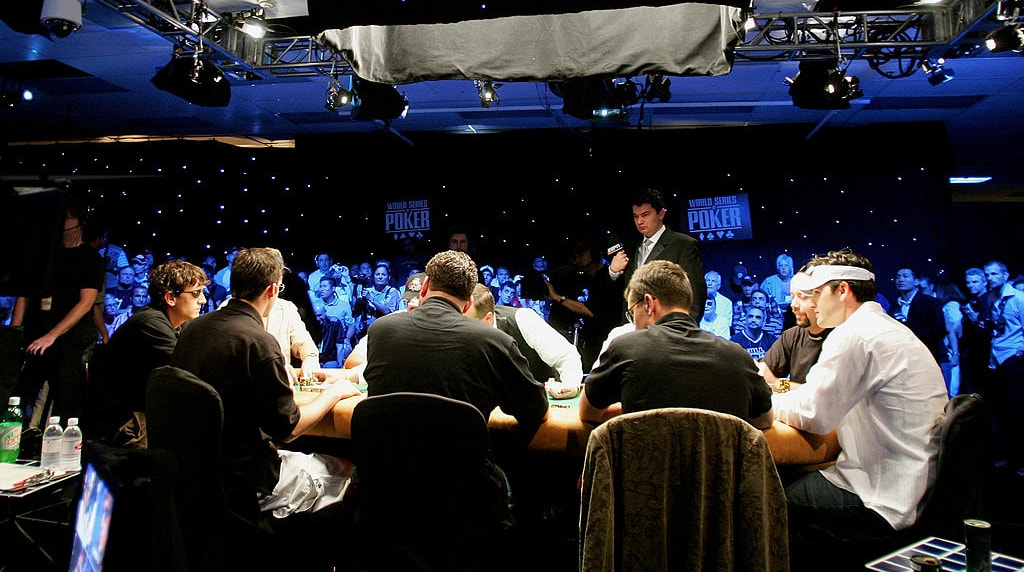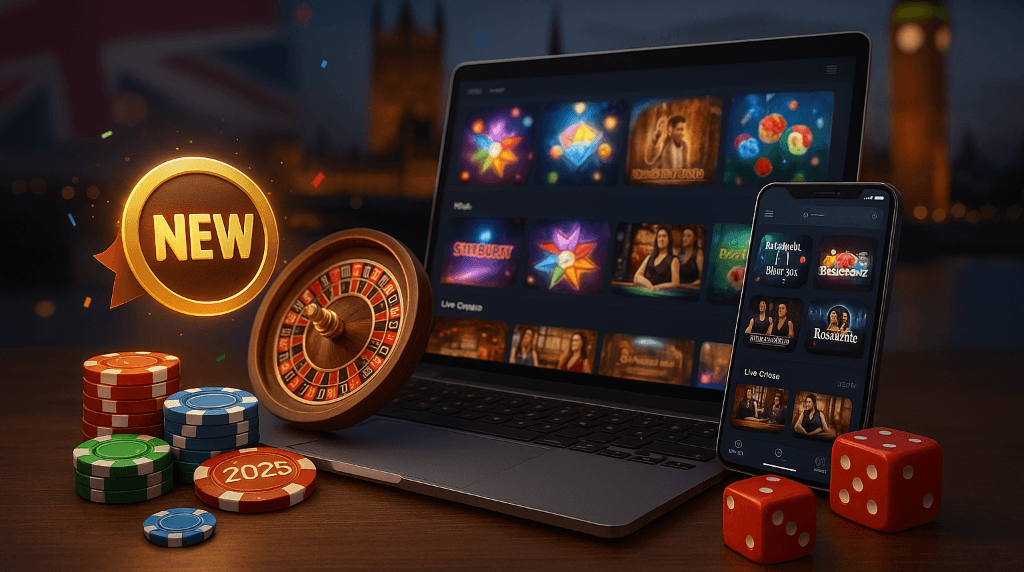The History of Televised Poker – Popularising the Game Beyond Belief
Televised poker has a fascinating history that reflects both the growth and diversification of television and the evolution of poker itself. Courtesy of television, poker boomed from 1999 onward. However, apart from Coronation Street, nothing lasts forever.

The 2005 World Series of Poker final table was broadcast on ESPN. © Getty Images
The History of Poker on Television
Over 25 years later, most televised poker is streamed online and watched only by hardcore devotees. But this is no cautionary tale. The best poker sites are enjoying a second honeymoon, with record numbers playing online and at marquee live events such as the World Series of Poker.
The impact television had on poker’s popularity, at a time when online poker was in its infancy, cannot be overestimated. It was a 21st century gold rush. Join us as we look at the history of televised poker from niche to mainstream and back again.
The Early Days: Late 1970s to 1990s
The World Series of Poker (WSOP) began life in 1970. It initially picked up little media attention outside of Las Vegas. Three years later, Jimmy’ the Greek’ Snyder narrated a package item for CBS Sports Spectacular.
It could have been a catalyst for the explosion in poker popularity that lay ahead, but that boom was still decades away. CBS did not return to the World Series until 1978 – presumably due to only moderate viewer interest – and the network covered the WSOP intermittently – in 1981 and 1983.
The $10,000 entry tournament was then ignored for four years before cable sports channel ESPN picked up the broadcast rights in 1987. Its production was basic and consisted of a one-hour highlights show.
In those early days, there were no hole card cameras and pre-recorded interviews with finalists were not considered. Nevertheless, ESPN’s airing of the 1988 WSOP final hand became one of the most famous moments in poker history, featured in the much-lauded movie “Rounders”.
ESPN continued to broadcast action from the World Series Main Event until 1998, albeit it skipped Huck Seed’s success in 1996. By 1999, and for a three-year run, The Discovery Channel’s cameras were at Binion’s Casino to cover the WSOP. Its one-hour shows were more of an event overview rather than tension-packed final table recaps.
1999 Was Poker’s Game Changer
1999 was an exceptional year for poker on television. An Irish documentary company attended the WSOP and struck it lucky when three Irish poker players reached the final table. Amongst them was the new champion, Noel Furlong. Its production, “The Million Dollar Deal”, was an outstanding success across Europe.
Meanwhile, Matt Damon and Edward Norton’s excellent poker movie, ‘Rounders’, released in September 1998, was well on its way to becoming a commercial success. Ultimately, it took twice its production cost at box offices worldwide. The film’s storyline involved a wannabe poker pro’s quest to get to Las Vegas and play the WSOP.
The Hole Cam Revolution
However, a Welsh production company, Presentable, and a made-for-TV show unrelated to the World Series proved to be the proverbial game-changer. Late Night Poker made its debut on the UK’s Channel 4 and became an instant hit.
The secret of its success was a six-player, one-winner proceeds to the final table [shootout] format. Furthermore, despite being patented in 1995 by Henry Orenstein, Late Night Poker was the first poker production to feature under-table cameras.
The show was filmed in a dark studio. It was often smoke-filled (as players could smoke), and viewers could taste an atmosphere of secrecy and tension. This combination of high stakes, hole cams, and intensity captivated the public.
Late Night Poker’s viewing figures soared despite only having a mid-week graveyard broadcast slot. Once they surpassed a million, additional series were quickly commissioned. Five more Late Night Poker tournaments were played before America broadcast its first poker with hole cams in 2002.
The success of Late Night Poker ignited televised poker in the UK. Renowned promoter Barry Hearn organised a ‘Poker Million’ filmed on the Isle of Man in 2000 and broadcast live on Sky Sports. Hearn reported it was watched by 30 million viewers worldwide. It became an annual televised event filmed in a London studio.
In 2001, Sky broadcast a three-part tournament filmed in Ireland – coincidentally won by your author. It was the world’s first poker tournament to feature commercial advertising via the hallowed ‘flop shot’. Its production company hurriedly filmed and broadcast the World Heads-Up Championship a few months later. It, too, was broadcast on Sky.
The Poker Boom: Early 2000s
America was watching from the sidelines. ESPN was back at the World Series in 2002 and dedicating two one-hour episodes to the final table; the broadcaster gave what it called “sneak peak” cameras some limited use in its production.
Two days after the 2002 WSOP final table, attention turned to the Five Diamond World Poker Classic, a $10,000 entry Texas Hold ’em competition. This was the first tournament of the first season of the World Poker Tour. It proved to be a watershed moment.
Eight months passed before the footage of Gus Hansen winning $556,460 in the Bellagio Casino aired on the Travel Channel on American cable television. Using hole cams, interactive graphics, and a “live sports feel”, viewers felt they were at the heart of the action. The show, like Late Night Poker beforehand, was a hit.
One year later, the World Poker Tour made its network debut on NBC with a special “Battle of Champions” tournament, which aired against CBS coverage of the Super Bowl XXXVIII pre-game show.
WPT’s success saw ESPN up its game for the 2003 World Series of Poker. It adopted many features characteristic of the emerging WPT series. There were improved graphics and enhanced coverage of the entire tournament – including a ‘Feature Table’ equipped with hole cams.
The Golden Age of Poker TV: Mid-2000s
Emerging online poker sites benefited greatly from the public’s surge in interest. They hit the jackpot when Chris Moneymaker won the 2003 WSOP Main Event. The part-time restaurant worker had a name made for news headlines and, having qualified for the competition online at a cost of $86, he had a story.
Appearances on chat shows, such as The Late Show with David Letterman, followed. It meant his historic win had a profound impact on the popularity of poker. It was coined: “The Moneymaker Effect”.
Resultantly, more and more televised poker began to spring up all over the globe, and TV executives saw the value in developing poker personalities and giving them celebrity status. John Duthie, who won the inaugural Poker Million in the UK, set up a tour that mirrored the WPT. He labelled it as the EPT (European Poker Tour).
Barry Hearn’s Matchroom Sports, famous for promoting darts, snooker and boxing, hijacked many of the channels on the Sky platform and delivered wallpaper coverage of tournaments and celebrity cash games, including various sports stars who played poker. All were sponsored by online poker rooms.
Poker tours offering players the chance of TV stardom became commonplace. In Ireland, there was an explosion in the popularity of televised poker, and the 2006 Irish Poker Open final table was broadcast live by the state broadcaster, RTE.
The Demise of Poker on TV
Was it the 2008 financial crisis? Was it poker’s ‘Black Friday’ when, in 2011, three major U.S. poker sites were shut down by the U.S. Department of Justice for illegal gambling, money laundering, and bank wire fraud? Or was it just a case of greed and overkill?

Final table, lights, cameras, action! Players are ready for their shot of fame at the WPT 2013 Borgata Poker Open. © WPT on Flickr
Whatever it was, poker on television collapsed like a house of cards. As quickly as it rose from obscurity and became a global phenomenon, it returned to the relative shadows. The last Poker Million was played and broadcast in 2010, and Late Night Poker went off the air in 2011.
Poker After Dark, an hour-long show aired on NBC in North America, was cancelled in 2011 after 474 episodes. While dropping poker from its sports channels, Sky gave the game a dedicated but obscure channel to promote its own online poker site. It trundled on until 2016 before closing.
Today, poker continues to be televised. However, of the tours and shows that remain, the broadcaster has been changed, and the new network hosts have not represented an upgrade – far from it in many cases.
Poker has shifted some of its broadcasting to streaming platforms like Twitch and PokerGO, where viewers can watch live events, cash games, and special series around the clock. Shows like ‘Poker Night in America’ and WSOP tournaments now blend traditional TV broadcasting with online streaming.
The Future of Televised Poker
So why did the general public begin to reach for their remote controls? Did poker become a victim of its own success? Overexposure is suspected for the big TV turn-off, but expert overkill could be the answer. Masses of graphics, expert opinions and analysis as deep as an ocean is poker Shangri-La for nerds but not casual viewers.
Online streaming is the new home for most televised poker, and, alongside esports, it has a significant fanbase on Twitch, YouTube and other streaming sites. Its poker shows generally lack the ingredients needed to entertain the general public: Fun, suspense and engaging characters.
Those still in possession of a VHS video machine, with aspirations of reinventing the genre, could do worse than revisit some of the classic Late Night Poker episodes. It was, after all, the first show to use under-table cameras. However, it cleverly used them in a minimalist way.
Undercooked observational commentary often mirrored the actual decision-making process of a poker player. Only late in the hand, at the time of a critical decision, would the other player’s cards be shown to the viewers. It was never clear if a startling bluff or an unexpectedly strong hand was about to be exposed.
Only time will tell if poker will ever return to our television screens and major broadcasters. If it does, lessons are there to be learned from the past. Remarkably, there are already 25 years of history to choose from.
 5 Newcomer Online Casinos That Impressed Our Team in 2025
5 Newcomer Online Casinos That Impressed Our Team in 2025
 5 Unique Benefits We Wish More Casino Sites Offered
5 Unique Benefits We Wish More Casino Sites Offered
 Top 5 Recommended Christmas Slots to Play in 2025
Top 5 Recommended Christmas Slots to Play in 2025
 5 Casino Sites That Offer Festive Bonuses to UK Players
5 Casino Sites That Offer Festive Bonuses to UK Players